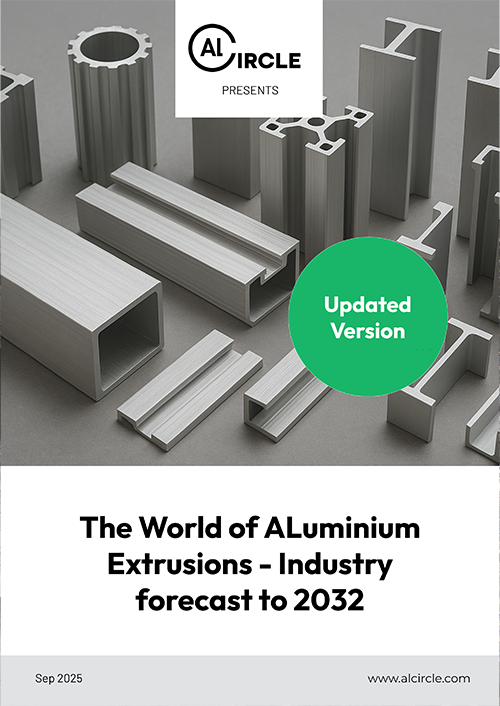The World of Aluminium Extrusions – Industry Forecast to 2032
Unlock in-depth insights into one of the fastest-growing segments of the global aluminium industry with our comprehensive market research report, The World of Aluminium Extrusions – Industry Forecast to 2032. This report provides a 360-degree view of the aluminium extrusion market, analysing capacity, production, consumption, trade flows, and future growth opportunities across all major regions and end-use sectors.
What does AL Circle’s report, "The World of Aluminium Extrusions – Industry Forecast to 2032", offer to you?
From transportation and building & construction to consumer durables, electronics, and renewable energy, aluminium extrusions are shaping industries worldwide. With growing applications, rising demand in emerging economies, and a stronger focus on sustainable materials, understanding this market is essential for businesses, investors, and policymakers.
Key highlights of the report
- Global Business Market Research – Detailed insights into world aluminium extrusions capacity, production, and usage with forecasts up to 2032.
- China Market Analysis & Other Regions – A deep dive into China’s dominant role in aluminium extrusion production, consumption, and trade, with comparisons against the rest of the world.
- Competitive Landscape Analysis – Profiles and trading details of leading aluminium extrusion manufacturers and traders, highlighting strategic moves, technological trends, and regional competition.
- Sector-Wise Demand Outlook – Forecasts of extrusion usage across transportation, construction, industrial, electrical & electronics, defence, consumer durables, and renewable sectors.
- Trade & Policy Dynamics – Impact assessment of tariffs, regional trade patterns, and material substitution trends (aluminium vs competing materials).
- Technology & Innovation – Latest developments in extrusion alloys, processes, and emerging applications that are transforming the industry.
What’s new in the report
- The report will now forecast to 2032
- Aluminium extrusion cost per tonne in 2025: Price overview and cost breakdown
- Impact analysis of tariffs on aluminium extrusions
- Materials substitution trends: Aluminium extrusions vs. competing materials
- Secondary aluminium capacity expansion by billet
- Selected company wise aluminium billets business analysis
- Selected company wise aluminium business analysis
- In-depth analysis of aluminium extrusion usage in the major sectors:
- I. Transportation
- II. Building & Construction
- III. Electrical & Electronics
- IV. Defence
- V. Renewable
- Key developments & investments in the aluminium extrusion sector
- Major shutdowns of aluminium extrusion plants with analysis
- Profiles of select aluminium extrusions manufacturers/producers and traders, with company names, line of business, product details, country of origin & contact person
- Selected aluminium extrusion company wise trading details
Who should read this report?
- Aluminium producers, processors, and traders
- Investors and financial institutions
- Policy makers and trade bodies
- Automotive, construction, and renewable sector stakeholders
- Business strategists and consultants looking for data-driven foresight
Stay ahead in a competitive market
As the aluminium extrusion industry evolves, staying informed on supply-demand shifts, pricing trends, and policy impacts is crucial. Our report equips you with actionable intelligence to navigate challenges and capture opportunities in this high-growth market.

Frequently asked questions
As of XXX, the world aluminium extrusion industry has a substantial production capacity, supported by both primary and secondary aluminium inputs. China dominates production, followed by Europe, North America, and Asia-Pacific, reflecting global industrial and infrastructure growth.
Strong demand growth is forecasted across Asia-Pacific (led by China and India), followed by North America and Europe. Infrastructure development, renewable energy adoption, and automotive lightweighting are the primary growth drivers.
Major end-use sectors include:
• Transportation (automotive, rail, aerospace, etc.)
• Building & construction
• Electrical & electronics
• Industrial machinery
• Consumer durables
• Defence
• Renewable energy applications
Tariff policies in regions like the US, EU, and China are influencing global trade flows, cost structures, and competitive dynamics. Protective tariffs have led to supply chain shifts, regional imbalances, and competitive pressures among manufacturers.
Aluminium faces competition from steel (strength and cost), plastics (lightweight & low cost), and composites (performance-driven applications). However, aluminium’s recyclability, corrosion resistance, and weight-to-strength ratio help it retain an edge in sustainable applications.
Recycled aluminium has become increasingly important due to sustainability goals, cost-effectiveness, and circular economy policies. The share of recycled aluminium is rising, particularly in Europe and North America, reducing dependency on primary aluminium.
• Billets are cylindrical and specifically designed for extrusion, ensuring uniformity and consistency.
• Ingots are larger cast forms, often requiring remelting before use.
Billets are preferred in extrusion processes due to their higher process efficiency and product quality.
Advancements include:
• Improved extrusion alloys for lightweight, high-strength applications.
• Automated extrusion lines for precision and efficiency.
• Innovations in surface finishing (anodising, powder coating).
• Digital simulation tools to optimise design and reduce production defects.
Emerging applications include:
• Renewable energy (solar panel frames, wind turbine structures)
• Electric vehicles (battery enclosures, lightweight body frames)
• Smart infrastructure (urban transport systems, smart grids)
The report profiles several manufacturers and traders, including regional leaders from China, Rest of Asia Pacific, Europe, North America, and the Middle East. These companies are expanding production capacity, investing in sustainability, and enhancing product innovation to stay competitive.



